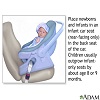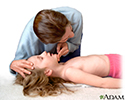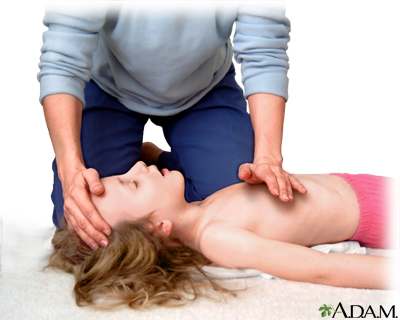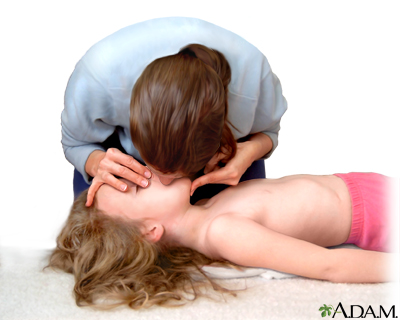CPR - child (1 to 8 years old)
Rescue breathing and chest compressions - child; Resuscitation - cardiopulmonary - child; Cardiopulmonary resuscitation - child
CPR stands for cardiopulmonary resuscitation. It is a lifesaving procedure that is done when a child's breathing or heartbeat has stopped. This may happen after drowning, suffocation, choking, or an injury. CPR involves:
- Rescue breathing, which provides oxygen to a child's lungs
- Chest compressions, which keep the child's blood circulating
Permanent brain damage or death can occur within minutes if a child's blood flow stops. Therefore, you must continue CPR until the child's heartbeat and breathing return, or trained medical help arrives.
Considerations
CPR is best done by someone trained in an accredited CPR course. The newest techniques emphasize compression over rescue breathing and airway management, reversing a long-standing practice.
All parents and those who take care of children should learn infant and child CPR if they have not already. See www.heart.org for classes near you.
Time is very important when dealing with an unconscious child who is not breathing. Permanent brain damage begins after only 4 minutes without oxygen, and death can occur as soon as 4 to 6 minutes later.
Unconscious
Unconsciousness is when a person is unable to respond to people and activities. Doctors often call this a coma or being in a comatose state. Other c...

Machines called automated external defibrillators (AEDs) can be found in many public places, and are available for home use. These machines have pads or paddles to place on the chest during a life-threatening emergency. They use computers to automatically check the heart rhythm and give a sudden shock if, and only if, that shock is needed to get the heart back into the right rhythm. When using an AED, follow the instructions exactly.
The procedures described in this article are NOT a substitute for CPR training.
Causes
There are many things that cause a child's heartbeat and breathing to stop. Some reasons you may need to do CPR on a child include:
- Choking
- Drowning
- Electrical shock
- Excessive bleeding
- Head trauma or serious injury
- Lung disease
- Poisoning
- Suffocation
Symptoms
CPR should be done if the child has any of the following symptoms:
-
No breathing
No breathing
Breathing that stops from any cause is called apnea. Slowed breathing is called bradypnea. Labored or difficult breathing is known as dyspnea....
Read Article Now Book Mark Article - No pulse
-
Unconsciousness
Unconsciousness
Unconsciousness is when a person is unable to respond to people and activities. Doctors often call this a coma or being in a comatose state. Other c...
 ImageRead Article Now Book Mark Article
ImageRead Article Now Book Mark Article
First Aid
1. Check for alertness. Shake or tap the child gently. See if the child moves or makes a noise. Shout, "Are you okay?"
2. If there is no response, shout for help. Tell someone to call 911 and get an AED if available. Do not leave the child alone until you have done CPR for about 2 minutes.
3. Carefully place the child on their back. If there is a chance the child has a spinal injury, two people should move the child to prevent the head and neck from twisting.
4. Perform chest compressions:
•Place the heel of one hand on the breastbone -- just below the nipples. Make sure your heel is not at the very end of the breastbone.
•Keep your other hand on the child's forehead, keeping the head tilted back.
•Press down on the child's chest so that it compresses about 1/3 to 1/2 the depth of the chest.
•Give 30 chest compressions. Each time, let the chest rise completely. These compressions should be fast and hard with no pausing. Count the 30 compressions quickly: "1,2,3,4,5,6,7,8,9,10,11,12,13,14,15,16,17,18,19,20,21,22,23,24,25,26,27,28,29,30, off”.
5. Open the airway. Lift up the chin with one hand. At the same time, tilt the head by pushing down on the forehead with the other hand.
6. Look, listen, and feel for breathing. Place your ear close to the child's mouth and nose. Watch for chest movement. Feel for breath on your cheek.
7. If the child is not breathing:
•Cover the child's mouth tightly with your mouth.
•Pinch the nose closed.
•Keep the chin lifted and head tilted.
•Give two rescue breaths. Each breath should take about a second and make the chest rise.
8. After about 2 minutes of CPR, if the child still does not have normal breathing, coughing, or any movement, leave the child if you are alone and call 911. If an AED for children is available, use it now.
9. Repeat rescue breathing and chest compressions until the child recovers or help arrives.
If the child starts breathing again, place him or her in the recovery position. Keep checking for breathing until help arrives.
Do Not
-
If you think the child has a
spinal injury
, pull the jaw forward without moving the head or neck. Do NOT let the mouth close.
Spinal injury
The spinal cord contains the nerves that carry messages between your brain and body. The cord passes through your neck and back. A spinal cord inju...
 ImageRead Article Now Book Mark Article
ImageRead Article Now Book Mark Article - If the child has signs of normal breathing, coughing, or movement, do NOT begin chest compressions. Doing so may cause the heart to stop beating.
- Unless you are a health professional, do NOT check for a pulse. Only a health care professional is properly trained to check for a pulse.
When to Contact a Medical Professional
- If you have help , tell one person to call 911 while another person begins CPR.
- If you are alone , shout loudly for help and begin CPR. After doing CPR for about 2 minutes, if no help has arrived, call 911. You may carry the child with you to the nearest phone (unless you suspect a spinal injury).
Prevention
Most children need CPR because of a preventable accident. The following tips may help prevent an accident:
- Teach your children the basic principles of family safety.
- Teach your child to swim.
- Teach your child to watch for cars and how to ride a bike safely.
-
Make sure you follow the guidelines for using
children's car seats
.
Children's car seats
Child safety seats are proven to save children's lives in accidents. In the United States, all states require children to be secured in a car seat or...
 ImageRead Article Now Book Mark Article
ImageRead Article Now Book Mark Article - Teach your child firearm safety. If you have guns in your home, keep them locked in an isolated cabinet.
- Teach your child the meaning of "don't touch."
Never underestimate what a child can do. Assume the child can move and pick up things more than you think they can. Think about what the child may get into next, and be ready. Climbing and squirming are to be expected. Always use safety straps on high chairs and strollers.
Choose age-appropriate toys. Do not give small children toys that are heavy or fragile. Inspect toys for small or loose parts, sharp edges, points, loose batteries, and other hazards. Keep toxic chemicals and cleaning solutions safely stored in childproof cabinets.
Create a safe environment and supervise children carefully, particularly around water and near furniture. Electrical outlets, stove tops, and medicine cabinets can be dangerous for small children.
References
American Red Cross. Pediatric First Aid/CPR/AED Ready Reference . Revised 6/14. Dallas, TX: American Red Cross; 2014.
Berg MD, Schexnayder SM, Chameides L, et al. Part 13: pediatric basic life support: 2010 American Heart Association guidelines for cardiopulmonary resuscitation and emergency cardiovascular care. Circulation . 2010;122(18 Suppl 3):S862-S875. PMID: 20956229 www.ncbi.nlm.nih.gov/pubmed/20956229 .
Cukor J, Manno M. Pediatric respiratory emergencies. In: Marx J, Hockberger RS, Walls RM, eds. Rosen's Emergency Medicine: Concepts and Clinical Practice . 8th ed. Philadelphia, PA: Elsevier Saunders; 2014:chap 168.
Donoghue AJ, Berg RA, Nadkarni V. Pediatric resuscitation. In: Marx JA, Hockberger RS, Walls RM, et al, eds. Rosen's Emergency Medicine: Concepts and Clinical Practice . 8th ed. Philadelphia, PA: Elsevier Saunders; 2014:chap 10.
Review Date: 4/12/2015
Reviewed By: Jacob L. Heller, MD, MHA, Emergency Medicine, Virginia Mason Medical Center, Seattle, WA. Also reviewed by David Zieve, MD, MHA, Isla Ogilvie, PhD, and the A.D.A.M. Editorial team.




